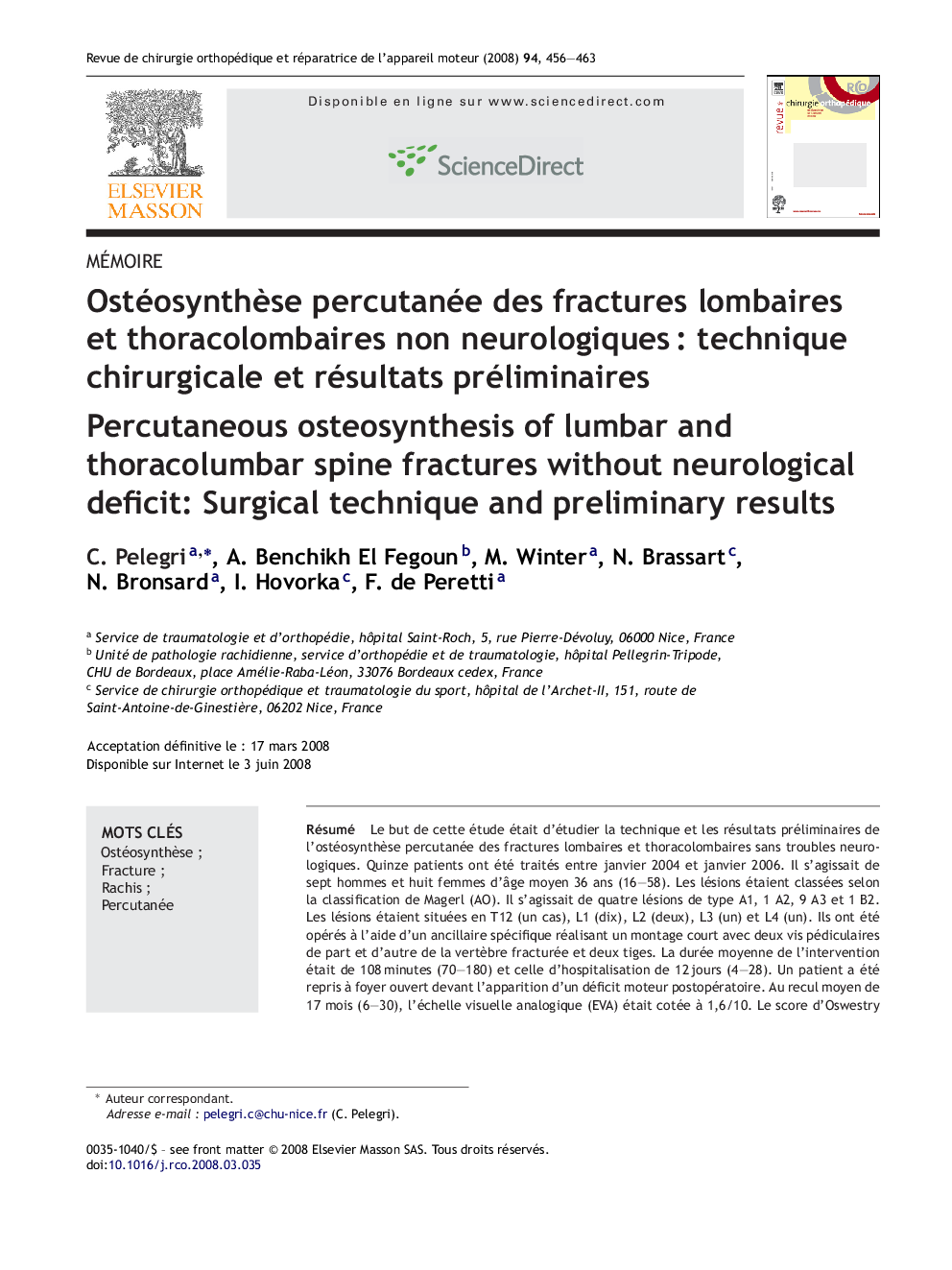| کد مقاله | کد نشریه | سال انتشار | مقاله انگلیسی | نسخه تمام متن |
|---|---|---|---|---|
| 4088322 | 1268101 | 2008 | 8 صفحه PDF | دانلود رایگان |

RésuméLe but de cette étude était d’étudier la technique et les résultats préliminaires de l’ostéosynthèse percutanée des fractures lombaires et thoracolombaires sans troubles neurologiques. Quinze patients ont été traités entre janvier 2004 et janvier 2006. Il s’agissait de sept hommes et huit femmes d’âge moyen 36 ans (16–58). Les lésions étaient classées selon la classification de Magerl (AO). Il s’agissait de quatre lésions de type A1, 1 A2, 9 A3 et 1 B2. Les lésions étaient situées en T12 (un cas), L1 (dix), L2 (deux), L3 (un) et L4 (un). Ils ont été opérés à l’aide d’un ancillaire spécifique réalisant un montage court avec deux vis pédiculaires de part et d’autre de la vertèbre fracturée et deux tiges. La durée moyenne de l’intervention était de 108 minutes (70–180) et celle d’hospitalisation de 12 jours (4–28). Un patient a été repris à foyer ouvert devant l’apparition d’un déficit moteur postopératoire. Au recul moyen de 17 mois (6–30), l’échelle visuelle analogique (EVA) était cotée à 1,6/10. Le score d’Oswestry moyen était de 16 points. La reprise du travail a eu lieu dans 75 % des cas. La cyphose vertébrale (CV) moyenne passait de 16 à 8,1°, l’angulation régionale corrigée (ARC) de 12 à 2,5°. La perte de correction au dernier recul était de 1,1° pour la CV et de 2,5° pour l’ARC. L’ostéosynthèse rachidienne percutanée est techniquement réalisable, mais nécessite un apprentissage. Les résultats fonctionnels et subjectifs sont bons. Les indications et les limites de la technique restent à préciser.
SummaryPurpose of the studyThe aim of this work was to study the technique of percutaneous osteosynthesis of lumbar and thoracolumbar spine fractures without neurological deficit and to report preliminary results.Material and methodsThis retrospective study included 15 patients with lumbar or thoracolumbar spine fractures who were treated between January 2004 and January 2006 by percutaneous osteosynthesis. There were seven men and eight women, mean age 36 years (range 16–58 years). The Magerl classification (AO) was A1 (n = 4), A2 (n = 1), A3 (n = 9), B2 (n = 1). Levels were T12 (n = 1), L1 (n = 10), L2 (n = 2), L3 (n = 1), L4 (n = 1). A specific instrument set was used to insert a short fixation using two pedicular screws on either side of the fractured vertebra and two prebent 5.5 mm rods introduced with an aiming device. The operation was performed under fluoroscopy. Ten patients wore a removable corset. The upright position was allowed if there were no other injuries. Computed-tomography scans were obtained preoperatively, postoperatively and at two years follow-up. Function was assessed with the Oswestry score.ResultsMean operative time was 108 minutes (range 40–180 minutes). None of the patients with an isolated spinal injury required blood transfusion. Mean hospital stay was 12 days (range 4–28). Results were expressed for 13 patients whose operations were exclusively percutaneous. Mean follow-up was 17 months (range 6–30). The visual analog scale (VAS) was 1.6/10. The mean Oswestry score was 16. Three quarters of the patients resumed their occupational activities. None of the patients was dissatisfied. Mean vertebral kyphosis (VK) improved from 16 to 8.1°, corrected regional angle (CRA) from 12 to 2.5° at last follow-up. Loss of correction at last follow-up was 1.1° for VK and 2.5° for CRA. The rate of pedicle screw malposition was 3.8%. There were no cases of disassembly nor material failure. There were no infections. None of the implants had to be removed.DiscussionPercutaneous osteosynthesis of the spine is technically feasible, but requires considerable experience. Functional and subjective results have been good. The loss of correction at last follow-up has been comparable to that observed with conventional open surgery. This technique is an intermediary method between orthopaedic treatment and conventional surgery. Exact indications must be established.ConclusionPercutaneous osteosynthesis of lumbar and thoracolumbar spine fractures is an attractive therapeutic option. Our results are encouraging. Indications and limitations of this technique must be carefully identified.
Journal: Revue de Chirurgie Orthopédique et Réparatrice de l'Appareil Moteur - Volume 94, Issue 5, September 2008, Pages 456–463